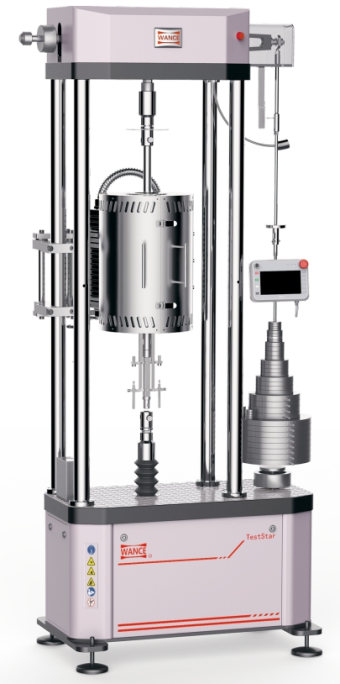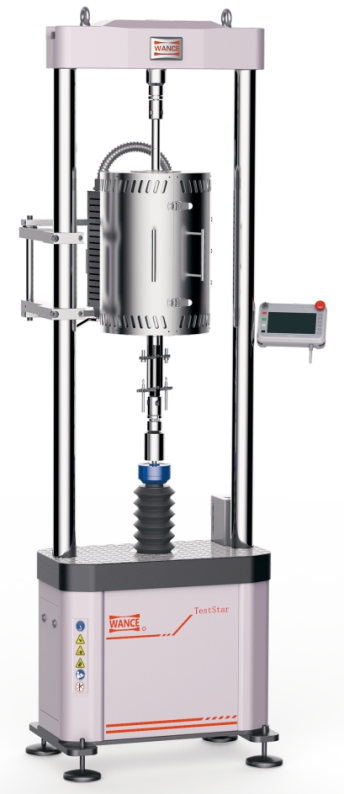
+86 755 23057280
English
How to improve creep test accuracy
High temperature test
Tensile property is one of the main performance indexes of metal materials, among which yield, tensile strength and other parameters are the most representative mechanical performance indexes of metal materials, and also the important basis for stress calculation in engineering design and mechanical design. For the metal materials used in high temperature environment such as aeroengines, pressure vessels, nuclear power equipment and heat pipelines, high-temperature tensile performance data is the most basic and essential assessment data.
Long time creep test
Although the current standards have unified the test methods, it is essential to have a tensile testing machine with reliable quality in order to accurately measure the high-temperature tensile properties of materials. Choosing a good tensile testing machine can improve the accuracy of test results to the greatest extent.
As a professional testing machine R & D, manufacturing, sales, service and mechanical performance testing technical solutions to provide, implementation as one of the national high-tech enterprises, WANCE is your best choice! At present, WANCE has two kinds of mechanical and electronic high temperature creep endurance testing machines, which can meet the test requirements.


Mechanical and motorized type creep testing machine
This type of machine is designed as low cost solutions for long-term creep and stress-rupture testing applications of metallic and alloy materials under high temperature in accordance with ASTM, BS, EN, ISO and other similar international testing standards.
GB/T 2039, HB 5151, HB 5150, ISO 204, ASTM E139
Model | TSC304-A | TSC504-A | TSC804-A | TSC105-A |
Maximum force | 30KN | 50KN | 80KN | 100KN |
Minimum force | 1500N | 2500N | 4000N | 5000N |
Force accuracy | ≤±0.5% | |||
Lower pull rod speed | 0.01~90mm/min | |||
Lower pull rod travel | 0-200mm | |||
Automatic level adjustment range | 0.1mm | |||
Lever arm ratio | 1:50 | |||
Axiality | ≤10% | |||
Timing accuracy | ±0.1% | |||
Power supply | 380V±10%;50Hz | |||
Power consumption | 0.5KW | 0.85KW | ||
Length x width x height | 960*540*2400(mm) | 1350*700*2430(mm) | ||
Weight | 1000KG (with weights) | 1400KG (with weights) | ||
Furnace Specifications
Name | Description |
Furnace type | Split |
Control | Three-zone |
Temperature range | 300~1100℃ |
Uniform temperature range | 150mm |
Furnace inside dimension | Φ110×320mm |
Outside dimension | Φ310×450mm |
Power consumption | 3kW |
Power supply | 3-phase, 380V±10% |
Temperature fluctuation / Temperature gradient | 300~600 ±2℃ 600~900 ±3℃ 900~1200 ±4℃ |
Name | Description |
Furnace type | Split type, GWL-1200-200 |
Control | Three-zone |
Temperature range | 200~1200℃ |
Uniform temperature range | 200mm |
Furnace inside dimension | Φ90×445mm |
Outside dimension | Φ350×500mm |
Power consumption | 5kW |
Power supply | 3-phase, 380V±10% |
Temperature fluctuation / Temperature gradient | 200~600 ±2℃ 600~900 ±3℃ 900~1200 ±4℃ |
Machine configuration
Name | Type/Brand | Model | Capacity | Remark |
Machine | TSC304-A | 30KN | ☐ | |
TSC504-A | 50KN | ☐ | ||
TSC804-A | 80KN | ☐ | ||
TSC105-A | 100KN | ☐ | ||
Furnace | Split type | GWL-1100-150 | 300℃ ~ 1100℃ | ☒ |
GWL-1200-200 | 200℃ ~ 1200℃ | ☐ | ||
Controller | SIEMENS | ☒ | ||
Temperature controller | SIEMENS Modular | ☒ | ||
Thermocouple | K | RDO-K-1000 | 0~1200℃ | ☒ |
S | RDO-S-1000 | 0~1600℃ | ☐ | |
Pull rod | Material: K418 | WGLG | ~900℃ | ☒ |
Material: DZ22 | WGLG-H | ~1200℃ | ☐ | |
Tensile grip (sample holder) | Material: K418 | GWJJ | ~900℃ | ☒ |
Material: DZ22 | GWJJ-H | ~1200℃ | ☐ | |
Extension rod | Material: K418 | GWYS | ~900℃ | ☒ |
Material: DZ22 | GWYS-H | ~1200℃ | ☐ | |
Height gauge | HEIDENHAIN | ST1278 | 12mm | ☒ |
ST3078 | 30mm | ☐ | ||
Computer | Lenovo | Computer | ☒ | |
Advantech | Industrial computer | ☐ | ||
Reverse tool for load calibration | 30KN | ☐ | ||
50KN | ☐ | |||
80KN | ☐ | |||
100KN | ☐ |
Test preparation
The standard specimen used in the tensile test of metal materials is made by machining the sample blank. This process usually includes the process of turning, milling, planing and grinding. In each machining process, the feeding speed and cooling speed should be controlled well to prevent the material performance from being affected by heat or cold working hardening.
For the processed standard sample, the size and roughness of the sample must meet the standard requirements first, which is the basis to ensure the accuracy of the test results. Then, according to the sample size, determine and mark the sample distance.
When marking distances, the characteristics of the sample material should be considered.
If the material is brittle, a marking pen should be applied to the surface of the sample, then a marking line should be lightly drawn. The marking pen paint should be chosen to ensure that the marking is still visible after the high temperature test.
For ductile materials, marks should be placed on the surface of the sample to ensure that the marks are still visible at high temperatures.
Temperature control
The heating process of high-temperature furnace usually has thermal inertia, and its temperature control has a certain hysteresis, the reason is that the temperature change speed of heating elements such as electric heating wire is far behind the speed of thermocouple temperature measurement, so that the actual temperature of high-temperature furnace is always lagging behind the set temperature, usually a few degrees to ten degrees of deviation.
In order to overcome this problem, the proportional - integral - differential (PID) temperature control method is recommended. At the same time, with the development of temperature control technology, new control methods such as fuzzy control, neural network control and fuzzy PID control are possible for high temperature furnace accurate control temperate zone. The mechanical/electronic high temperature creep endurance testing machine adopts imported 0.1 grade Siemens temperature control module, PID automatic closed-loop control, with PID parameter automatic adjustment function, self-setting function can be realized through the test software/touch screen, PID parameters can be adjusted in real time.
It is worth noting that, because of the different heat dissipation rates of the upper, middle and lower areas of the furnace, the heating power of the three areas needs different Settings in order to realize the precise control of the temperature required by the test. Generally speaking, the heating power required in the upper and lower regions is slightly larger than that in the middle region, because the heat exchange between the upper and lower ends of the high-temperature furnace and the cold air is larger than that in the middle region.
In addition, in order to better control the test temperature, the temperature control system measure high temperature creep endurance testing machine is highly integrated in the main machine, which does not need an independent temperature control cabinet, so as not to occupy additional laboratory space. The high integration can also shorten the distance of temperature compensation wire, ensuring the temperature control accuracy.
Tensile test process
The temperature is the most difficult to control during sample loading. The sample is subjected to stress and yields. Due to the elastic deformation stage, the sample itself does not generate heat, and the temperature is easily controlled at this stage. However, from the yield deformation stage, the sample will undergo plastic deformation, resulting in the heat generated by the sample itself, which may lead to the temperature of the sample rising by tens of degrees Celsius (such as austenitic stainless steel), and the temperature of the sample itself rising, resulting in the test temperature being difficult to control or even beyond the specified test temperature.
Therefore, it is necessary to control the negative deviation of the test temperature within the specified temperature range in the initial loading stage of tensile to prevent the later temperature from exceeding the standard. At the same time, it is necessary to pay attention to the temperature change during the loading process and make necessary manual adjustment to the heating controller in time.
To sum up, in the process of high temperature tensile test for metal materials, it is necessary not only to select high quality and high standard testing machine products, but also to correctly understand the special operation details of high temperature tensile test. In the daily inspection work, we should be good at accumulating and summarizing various phenomena and rules in the long-term test process, constantly improving the accuracy of test results, and providing reliable and effective test data for scientific research and enterprise production.